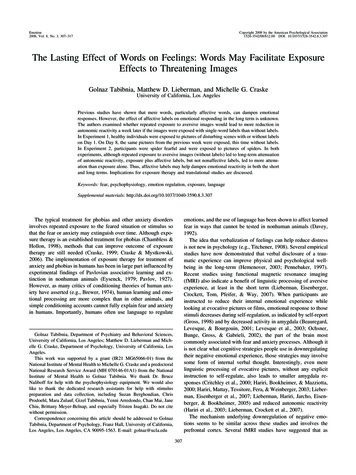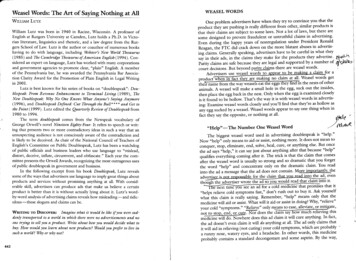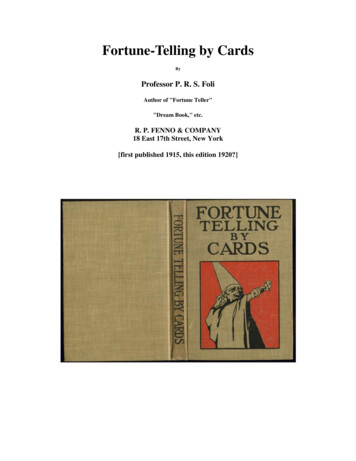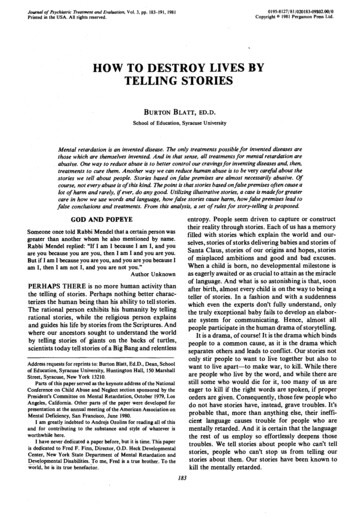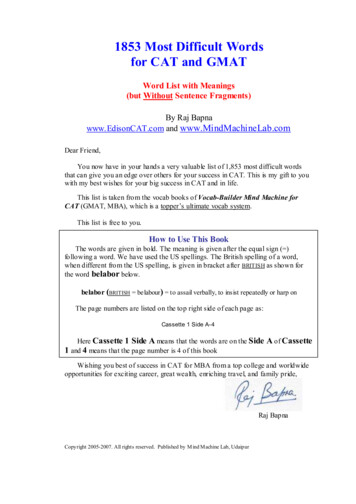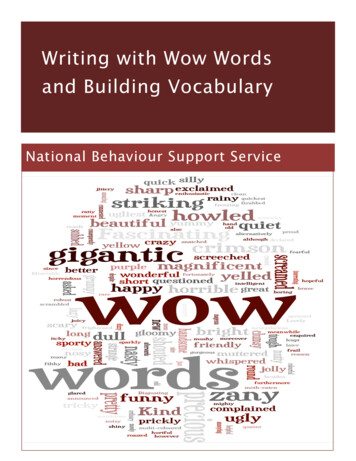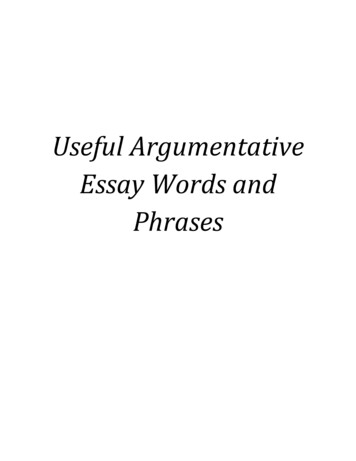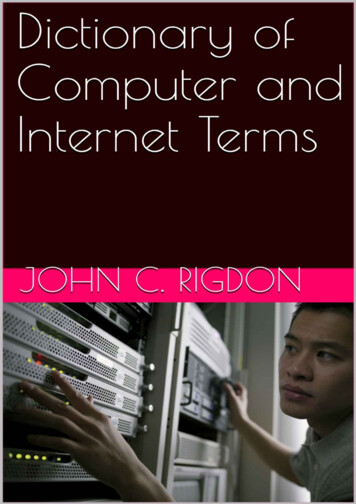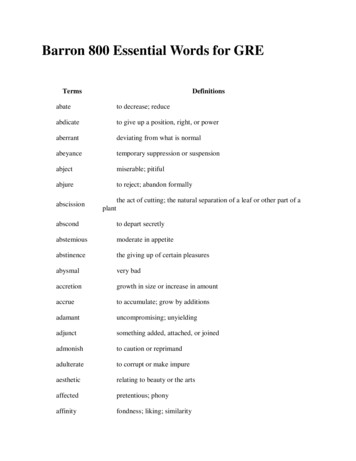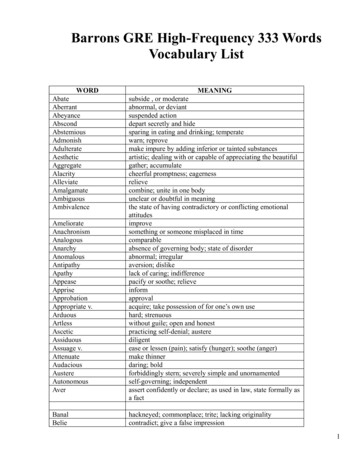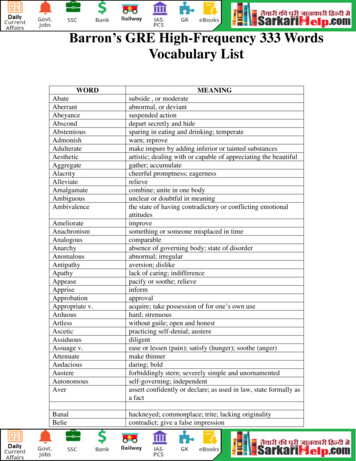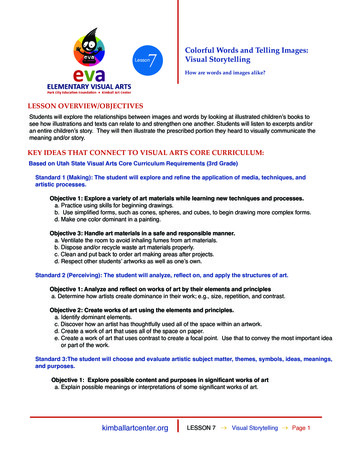
Transcription
7LessonColorful Words and Telling Images:Visual StorytellingHow are words and images alike?LESSON OVERVIEW/OBJECTIVESStudents will explore the relationships between images and words by looking at illustrated children’s books tosee how illustrations and texts can relate to and strengthen one another. Students will listen to excerpts and/oran entire children’s story. They will then illustrate the prescribed portion they heard to visually communicate themeaning and/or story.KEY IDEAS THAT CONNECT TO VISUAL ARTS CORE CURRICULUM:Based on Utah State Visual Arts Core Curriculum Requirements (3rd Grade)Standard 1 (Making): The student will explore and refine the application of media, techniques, andartistic processes.Objective 1: Explore a variety of art materials while learning new techniques and processes.a. Practice using skills for beginning drawings.b. Use simplified forms, such as cones, spheres, and cubes, to begin drawing more complex forms.d. Make one color dominant in a painting.Objective 3: Handle art materials in a safe and responsible manner.a. Ventilate the room to avoid inhaling fumes from art materials.b. Dispose and/or recycle waste art materials properly.c. Clean and put back to order art making areas after projects.d. Respect other students’ artworks as well as one’s own.Standard 2 (Perceiving): The student will analyze, reflect on, and apply the structures of art.Objective 1: Analyze and reflect on works of art by their elements and principlesa. Determine how artists create dominance in their work; e.g., size, repetition, and contrast.Objective 2: Create works of art using the elements and principles.a. Identify dominant elements.c. Discover how an artist has thoughtfully used all of the space within an artwork.d. Create a work of art that uses all of the space on paper.e. Create a work of art that uses contrast to create a focal point. Use that to convey the most important ideaor part of the work.Standard 3:The student will choose and evaluate artistic subject matter, themes, symbols, ideas, meanings,and purposes.Objective 1: Explore possible content and purposes in significant works of arta. Explain possible meanings or interpretations of some significant works of art.kimballartcenter.orgLESSON 7 Visual Storytelling Page 1
7LessonColorful Words and Telling Images:Visual StorytellingObjective 2: Discuss, evaluate, and choose symbols, ideas, subject matter, meanings, and purposes for theirown artworks.a. Group significant works of art according to theme or subject matterb. Judge which works of art most clearly communicate through the use of symbols.c. Create symbols in art that express individual or group interests.d. Create a work of art that uses a similar subject matter, symbol, idea, and/or meaning found in a significantwork of art.KEY IDEAS THAT CONNECT VISUAL ARTS AND WRITING Images and illustrations can communicate ideas and express emotions. Words can be visual and can create pictures in your mind. Combining words and images thoughtfully can deepen their meanings.INSTRUCTIONAL OBJECTIVES:Students will:Visual Arts and Writing Identify descriptive words Understand that descriptive words can bring images to mind Look at illustrated children’s books to see how images and words strengthen each other Create images that illustrate words and/or a story that they hearFOR THE TEACHERSelect a dozen or more illustrated children’s books to show students as examples of the ways words and images support each other. Try to find many different illustration styles and text designs to show students the varietyof options there are for combining words and images. Select a short passage with lots of descriptive, visualwords from one of the books to read to students. Below is a list of books for ideas and you can also ask yourschool or local librarian for additional help.Use the Children’s Book List on the ABC website for ideas and askyour school or local librarian for additional help.Illustrated Children’s BooksThe books listed below are good examples of ways text and illustrations can complement each other andcontribute to the overall meaning of a story and of the variety of ways to arrange text on a page.A Poke in the I: A Collection of Concrete Poems by Paul B. Janeczko and Chris RaschkaArt by Patrick McDonnellGone Wild: An Endangered Animal Alphabet by David McLimansImagine by Norman MessengerImagine a Day by Sarah L. Thomson and Rob GonsalvesMath Curse by Jon Scieszka and Lane SmithMonkey Business by J. Otto Seibold and Vivian Walshkimballartcenter.orgLESSON 7 more Visual Storytelling Page 2
7Colorful Words and Telling Images:Visual StorytellingLessonIllustrated Children’s Books continued:Moses: When Harriet Tubman Led Her People to Freedom by Carol Boston Weatherford and Kadir NelsonSmokey Night by Eve Bunting and David DiazThe Three Pigs by David WiesmanWhat Do You Do With a Tail Like This? by Robin Page and Steve JenkinsWolves by Emily GravettWhy? by Lila PrapSUPPLIES Drawing Paper Student’s art exploration sheets, for reference Pencils, crayons, colored pencils, markers, watercolor paints, and brushesVOCABULARYDescriptive words - Describes how things feel, sound, taste, look, or smell in a way that creates vivid imagesin our minds.Narrative- Refers to a work of art that tells a story.Setting- Is the time and place where a subject is located or a story happens.Subject- Is who or what the artwork is about. It can be a story, an idea, a person, an emotion, or a feeling.Symbol- Is an object or thing that has meaning more than the thing itself. A dog might represent fidelity in addition tobeing a pet; it is a visual sign for an idea or concept.Foreground- Is the part of the picture that seems closest to the viewer.Symbolism - Is the practice or art of using an object or a word to represent an abstract idea. An action, person, place,word, or object can all have a symbolic meaning.Background- Is the part of the picture that seems farthest from the viewer.Middle ground- Is the part of the picture midway between the foreground and background.Elements of art - Are color, line, shape, form, space, value, and texture. Artists use these tools to create all visualart—representational, abstract, and non-representational.kimballartcenter.orgLESSON 7 Visual Storytelling Page 3
7LessonColorful Words and Telling Images:Visual StorytellingINSTRUCTIONAL PLANQuick Writing and/or discussionBefore beginning the lesson, give students a few minutes to respond to one of the following prompts: List the five words you like best or find most interesting. Describe the image created in your mind by the phrases “roller coaster” or “outer space.”IntroductionIntroduce this lesson by asking students to think of words that create vivid pictures in their minds. What are someexamples of descriptive or “juicy” words? Ask students if they think the following words are juicy and, if not, havestudents replace the original words with other words that are more visual: cold, loud, nice, squishy, and good. Whatimages do these words bring to mind? Choose a food (pizza, mango, cauliflower) or a place (home, bus, cafeteria) andask students to come up with visual words to describe it. How do these words help them “see” what is being described?Tell students they will explore how images and words work together to communicate and create images that express themeaning of words, phrases, or sentences they have written.Observe: Look and DiscussRead the passage you selected from an illustrated children’s book to students. Do not show them the illustrations. Tohelp them concentrate on the story and to visualize the scene and action taking place, ask students to close their eyesas they listen. Read the passage again and then ask some students to describe what they “saw” as you read. Whichwords from the passage were most descriptive or visual? Show students the illustration in the book so they can see howthe illustrator imagined the scene. How do the students’ visions compare to each other’s and to the illustrator’s? Howare they similar or different?Give students some time to look through the illustrated books borrowed from the library and see the many ways wordsand images can work together. Point out some examples you think are interesting and ask students to share any thatthey especially like.Create: Word ImagesRead the passage or story again to the students. Give them paper to practice their drawings of what they heard.Emphasize that images can describe and/or enhance words. When students are ready for their final drawing, havethem decide which art materials they will use. To create their image(s) for the story or passage they heard, they canbegin with a quick, preliminary sketch or they can begin creating their final illustrations. The illustrations can be realisticor abstract.Suggest that students can include the words somewhere on the page (optional). They can refer back to the illustratedbooks for different ways the text can be placed on the page.ReflectWhen students have finished, display their work in the classroom and give them a few minutes to look at each other’simages. Ask a few students to explain how their images and words relate. Ask other students to make observationsabout their classmates’ workkimballartcenter.orgLESSON 7 Visual Storytelling Page 4
7LessonColorful Words and Telling Images:Visual StorytellingLESSON EXTENSIONSVisual Arts and Writing Ask students to choose a juicy word and illustrate the word itself so that it helps communicate the meaning. Forexample, the word “juicy” could be made to look like it was made out of fruit and dripping juice. Have students create a visual poem. A visual poem is one in which the arrangement of words on the page helpsconvey the poem’s message; the arrangement can be as important as the meaning of the words. Ask them to write about a memorable meal using as many descriptive words as possible.lesson credit: artbookscreativity.orgADDITIONAL rgProject Zero: www.pz.harvard.eduVisual Thinking Strategies VTS: www.vtshome.orgkimballartcenter.orgLESSON 7 Visual Storytelling Page 5
Moses: When Harriet Tubman Led Her People to Freedom by Carol Boston Weatherford and Kadir Nelson Smokey Nigh t by Eve Bunting and David Diaz The Three Pigs by David Wiesman
